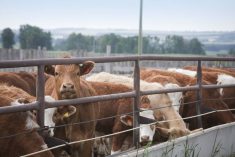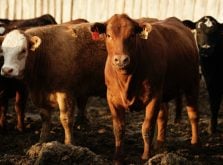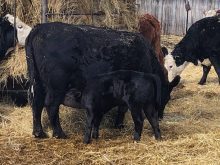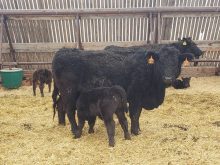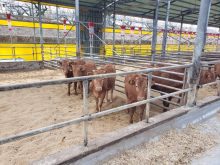Many producers are retaining more replacement heifers than in previous years. There are many good reasons to do so, but if so they should assure that unbred replacements are receiving adequate midwinter nutrition in order to be ready for breeding in the spring and ready to give birth to their first healthy calf.
Given that the breeding season is about four to six months away, unbred replacement heifers should be put on a steady plane of nutrition where they gain about 0.5-1.5 lb. per head daily. This growth should also parallel their body condition. For example, a young unbred beef heifer should maintain a midwinter body condition score (BCS) of 3.0-3.5 (1 = emaciated to 5 = obese) to achieve at least one strong estrus cycle before being bred, as well as being prepared for breeding at least three weeks before the main cow herd’s breeding season.
Read Also

Harvest wraps up and fall work begins
At the Eppich famly ranch in western Saskatchewan, the fall harvest was successful with few breakdowns, cows and calves have been sorted and a new tractor has arrived
Similarly, bred/gestating first-calf heifers should also achieve or maintain the same growth rates as well as 3.0-3.5 BCS at calving to achieve their own objectives which include: 1. Having a trouble-free calving season; 2. Returning to active estrus cycles; and 3. Getting pregnant by 80-85 days post-calving in order to synchronize with the cow herd’s annual calving interval.
Whether unbred or gestating, one of the biggest challenges to feeding all of these replacement heifers is that they require about 20-30 per cent more dietary energy, protein and other nutrients compared to mature cows (re: 1,200 lbs, BCS = 3.0). While they require more energy, keep in mind that they also have about 20 per cent less feed intake capacity. Furthermore, their dietary energy intake and its metabolism is prioritized — first for vital body functions and physical activity, then for heifer growth and/or pregnancy, and lastly for activating estrus cycles and conception.
Feed heifers separately
As a beef nutritionist, that is why I recommend producers segregate their replacement heifers in the early winter and feed them a good plane of nutrition. This means they should be fed a nearly all-forage diet of fair to high quality, encompassing a final TDN energy level of 55-58 per cent and protein level of 11-12 per cent. A good mineral-vitamin premix should also be provided at two to four ounces to complement forage levels of calcium, phosphorus and magnesium as well as fortified levels of trace minerals and vitamins A, D and E.
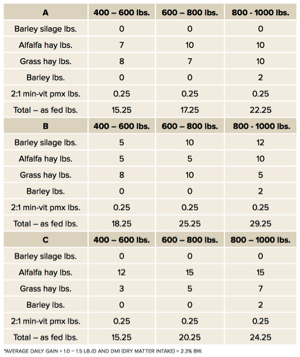 The accompanying table here shows three examples of good overwintering diets for 400-600 lb. and 600-800 lb. unbred heifers as well as for 800-1,000 lb. gestating replacement heifers.*
The accompanying table here shows three examples of good overwintering diets for 400-600 lb. and 600-800 lb. unbred heifers as well as for 800-1,000 lb. gestating replacement heifers.*
The biggest value of feeding these replacement heifer diets is that they are well balanced, yet practical enough that changes can be made. easily For example, I consult with a family that runs a 250 red Angus x Simmental cow herd. This past fall, they kept back about 50 weaned replacement heifers weighing on average about 650-700 lbs. From the start of this winter, they feed a similar diet as outlined in Diet B, and yet they realize that poor weather in January and February is inevitable, which can increase heifers’ dietary energy requirements by as much as 50 per cent. So they plan to add two to three pounds of barley per head.
This is a good testimony that good nutrition is necessary to maintain good growth and body condition in young growing unbred replacement heifers as well as those that are already carrying their first calf. It becomes a matter of common sense to raise these animals that will one day become part of the main cow herd.





